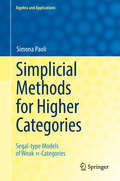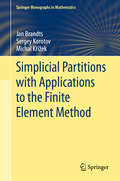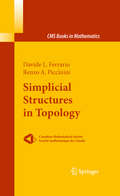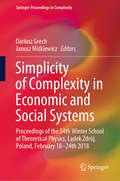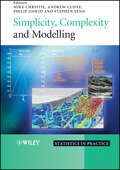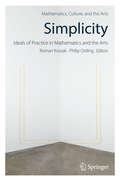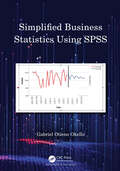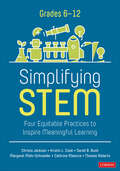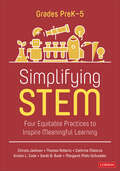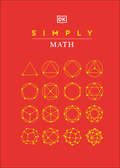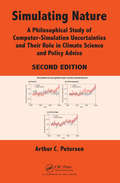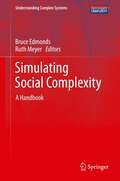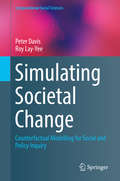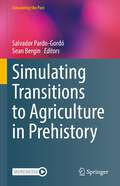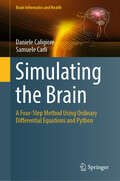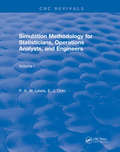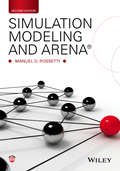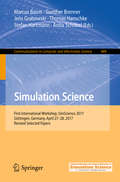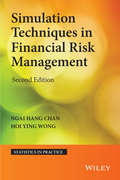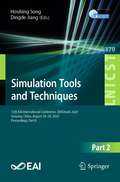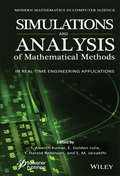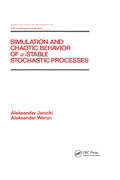- Table View
- List View
Simplicial Methods for Higher Categories: Segal-type Models of Weak n-Categories (Algebra and Applications #26)
by Simona PaoliThis monograph presents a new model of mathematical structures called weak n-categories. These structures find their motivation in a wide range of fields, from algebraic topology to mathematical physics, algebraic geometry and mathematical logic. While strict n-categories are easily defined in terms associative and unital composition operations they are of limited use in applications, which often call for weakened variants of these laws. The author proposes a new approach to this weakening, whose generality arises not from a weakening of such laws but from the very geometric structure of its cells; a geometry dubbed weak globularity. The new model, called weakly globular n-fold categories, is one of the simplest known algebraic structures yielding a model of weak n-categories. The central result is the equivalence of this model to one of the existing models, due to Tamsamani and further studied by Simpson. This theory has intended applications to homotopy theory, mathematical physics and to long-standing open questions in category theory. As the theory is described in elementary terms and the book is largely self-contained, it is accessible to beginning graduate students and to mathematicians from a wide range of disciplines well beyond higher category theory. The new model makes a transparent connection between higher category theory and homotopy theory, rendering it particularly suitable for category theorists and algebraic topologists. Although the results are complex, readers are guided with an intuitive explanation before each concept is introduced, and with diagrams showing the interconnections between the main ideas and results.
Simplicial Partitions with Applications to the Finite Element Method (Springer Monographs in Mathematics)
by Jan Brandts Sergey Korotov Michal KřížekThis monograph focuses on the mathematical and numerical analysis of simplicial partitions and the finite element method. This active area of research has become an essential part of physics and engineering, for example in the study of problems involving heat conduction, linear elasticity, semiconductors, Maxwell's equations, Einstein's equations and magnetic and gravitational fields.These problems require the simulation of various phenomena and physical fields over complicated structures in three (and higher) dimensions. Since not all structures can be decomposed into simpler objects like d-dimensional rectangular blocks, simplicial partitions are important. In this book an emphasis is placed on angle conditions guaranteeing the convergence of the finite element method for elliptic PDEs with given boundary conditions. It is aimed at a general mathematical audience who is assumed to be familiar with only a few basic results from linear algebra, geometry, and mathematical and numerical analysis.
Simplicial Structures in Topology
by Davide L. Ferrario Renzo A. PiccininiSimplicial Structures in Topology provides a clear and comprehensive introduction to the subject. Ideas are developed in the first four chapters. The fifth chapter studies closed surfaces and gives their classification. The last chapter of the book is devoted to homotopy groups, which are used in short introduction on obstruction theory. The text is more in tune with the original development of algebraic topology as given by Henry Poincaré (singular homology is discussed). Illustrative examples throughout and extensive exercises at the end of each chapter for practice enhance the text. Advanced undergraduate and beginning graduate students will benefit from this book. Researchers and professionals interested in topology and applications of mathematics will also find this book useful.
Simplicity of Complexity in Economic and Social Systems: Proceedings of the 54th Winter School of Theoretical Physics, Lądek Zdrój, Poland, February 18–24th 2018 (Springer Proceedings in Complexity)
by Dariusz Grech Janusz MiśkiewiczThis book presents the Proceedings of the 54th Winter School of Theoretical Physics on Simplicity of Complexity in Economic and Social Systems, held in Lądek Zdrój, Poland, from 18 to 24 February 2018. The purpose of the book is to introduce the new interdisciplinary research that links statistical physics, and particular attention is given to link physics of complex systems, with financial analysis and sociology. The main tools used in these areas are numerical simulation of agents behavior and the interpretation of results with the help of complexity methods, therefore a background in statistical physics and in physics of phase transition is necessary to take the first steps towards these research fields called econophysics and sociophysics. In this perspective, the book is intended to graduated students and young researchers who want to begin the study of this established new area, which connects physicists, economists, sociologists and IT professionals, to better understand complexity phenomena existing not only in physics but also in complex systems being seemingly far from traditional view at physics.
Simplicity, Complexity and Modelling
by Philip Dawid Mike Christie Stephen S. Senn Andrew CliffeSeveral points of disagreement exist between different modelling traditions as to whether complex models are always better than simpler models, as to how to combine results from different models and how to propagate model uncertainty into forecasts. This book represents the result of collaboration between scientists from many disciplines to show how these conflicts can be resolved.Key Features:Introduces important concepts in modelling, outlining different traditions in the use of simple and complex modelling in statistics. Provides numerous case studies on complex modelling, such as climate change, flood risk and new drug development. Concentrates on varying models, including flood risk analysis models, the petrol industry forecasts and summarizes the evolution of water distribution systems. Written by experienced statisticians and engineers in order to facilitate communication between modellers in different disciplines. Provides a glossary giving terms commonly used in different modelling traditions. This book provides a much-needed reference guide to approaching statistical modelling. Scientists involved with modelling complex systems in areas such as climate change, flood prediction and prevention, financial market modelling and systems engineering will benefit from this book. It will also be a useful source of modelling case histories.
Simplicity: Ideals of Practice in Mathematics and the Arts
by Roman Kossak Philip OrdingTo find "criteria of simplicity" was the goal of David Hilbert's recently discovered twenty-fourth problem on his renowned list of open problems given at the 1900 International Congress of Mathematicians in Paris. At the same time, simplicity and economy of means are powerful impulses in the creation of artworks. This was an inspiration for a conference, titled the same as this volume, that took place at the Graduate Center of the City University of New York in April of 2013. This volume includes selected lectures presented at the conference, and additional contributions offering diverse perspectives from art and architecture, the philosophy and history of mathematics, and current mathematical practice.
Simplified Business Statistics Using SPSS
by Gabriel Otieno OkelloStatistics are used throughout businesses to present and analyse data and decide on best practice. Simplified Business Statistics Using SPSS provides a practical approach to these concepts and their applications in business, economics and other areas of data analytics. This book guides the reader though these concepts without assuming prior knowledge and is an ideal reference for business analytics students and researchers in related fields. Features Includes simplified statistical contents and a step-by-step guide on how to apply statistical concepts by perform analysis using Statistical Package for Social Sciences together with an interpretation of the statistical analysis output Provides a wide range of data sets to be used for examples and illustrations Designed to be accessible to readers with varied backgrounds
Simplifying STEM [6-12]: Four Equitable Practices to Inspire Meaningful Learning (Corwin Mathematics Series)
by Sarah B. Bush Kristin L. Cook Margaret J. Mohr-Schroeder Christa Jackson Oliver Roberts Cathrine MaiorcaStart, focus, or extend your integrated STEM education journey with an authentic interdisciplinary perspective! In response to calls for active STEM learning that builds students’ agency and sense of belonging, teachers and leaders are being encouraged more and more to equitably implement integrated STEM instruction. This practical guidebook is designed to help educators create integrated STEM learning experiences that are inclusive for all students and allows them to experience STEM as scientists, innovators, mathematicians, creators, engineers, and technology experts! Addressing the STEM status quo and promoting inclusiveness in STEM fields, the authors center their work around the Equity-Oriented Conceptual Framework for STEM Literacy, which provides high-quality integrated strategies to connect students′ lived experiences to STEM learning. Simplifying STEM provides a ground-breaking model of the four Integrated STEM Practices (ISPs) to ensure coherent and aligned teaching across disciplines through authentic opportunities to meaningfully engage students. Learn how to simplify STEM with these four equitable practices to inspire deep learning Use critical and creative thinking to seek solutions Collaborate and use appropriate tools to engage in iterative design Communicate solutions based on evidence and data Recognize and use structures in real-world systems Including a STEM planning guide as well as instructional strategies and assessments for standard alignment, this is an essential resource for any educator seeking to empower their students with meaningful STEM learning experiences. The book includes an online implementation toolkit to give educators opportunities for powerful professional development built on collaboration and connection.
Simplifying STEM [6-12]: Four Equitable Practices to Inspire Meaningful Learning (Corwin Mathematics Series)
by Sarah B. Bush Kristin L. Cook Margaret J. Mohr-Schroeder Christa Jackson Oliver Roberts Cathrine MaiorcaStart, focus, or extend your integrated STEM education journey with an authentic interdisciplinary perspective! In response to calls for active STEM learning that builds students’ agency and sense of belonging, teachers and leaders are being encouraged more and more to equitably implement integrated STEM instruction. This practical guidebook is designed to help educators create integrated STEM learning experiences that are inclusive for all students and allows them to experience STEM as scientists, innovators, mathematicians, creators, engineers, and technology experts! Addressing the STEM status quo and promoting inclusiveness in STEM fields, the authors center their work around the Equity-Oriented Conceptual Framework for STEM Literacy, which provides high-quality integrated strategies to connect students′ lived experiences to STEM learning. Simplifying STEM provides a ground-breaking model of the four Integrated STEM Practices (ISPs) to ensure coherent and aligned teaching across disciplines through authentic opportunities to meaningfully engage students. Learn how to simplify STEM with these four equitable practices to inspire deep learning Use critical and creative thinking to seek solutions Collaborate and use appropriate tools to engage in iterative design Communicate solutions based on evidence and data Recognize and use structures in real-world systems Including a STEM planning guide as well as instructional strategies and assessments for standard alignment, this is an essential resource for any educator seeking to empower their students with meaningful STEM learning experiences. The book includes an online implementation toolkit to give educators opportunities for powerful professional development built on collaboration and connection.
Simplifying STEM [PreK-5]: Four Equitable Practices to Inspire Meaningful Learning (Corwin Mathematics Series)
by Sarah B. Bush Kristin L. Cook Margaret J. Mohr-Schroeder Christa Jackson Oliver Roberts Cathrine MaiorcaStart, focus, or extend your integrated STEM education journey with an authentic interdisciplinary perspective! In response to calls for active STEM learning that builds students’ agency and sense of belonging, teachers and leaders are being encouraged more and more to equitably implement integrated STEM instruction. This practical guidebook is designed to help educators create integrated STEM learning experiences that are inclusive for all students and allows them to experience STEM as scientists, innovators, mathematicians, creators, engineers, and technology experts! Addressing the STEM status quo and promoting inclusiveness in STEM fields, the authors center their work around the Equity-Oriented Conceptual Framework for STEM Literacy, which provides high-quality integrated strategies to connect students′ lived experiences to STEM learning. Simplifying STEM provides a ground-breaking model of the four Integrated STEM Practices (ISPs) to ensure coherent and aligned teaching across disciplines through authentic opportunities to meaningfully engage students. Learn how to simplify STEM with these four equitable practices to inspire deep learning Use critical and creative thinking to seek solutions Collaborate and use appropriate tools to engage in iterative design Communicate solutions based on evidence and data Recognize and use structures in real-world systems Including a STEM planning guide as well as instructional strategies and assessments for standard alignment, this is an essential resource for any educator seeking to empower their students with meaningful STEM learning experiences. The book includes an online implementation toolkit to give educators opportunities for powerful professional development built on collaboration and connection.
Simplifying STEM [PreK-5]: Four Equitable Practices to Inspire Meaningful Learning (Corwin Mathematics Series)
by Sarah B. Bush Kristin L. Cook Margaret J. Mohr-Schroeder Christa Jackson Oliver Roberts Cathrine MaiorcaStart, focus, or extend your integrated STEM education journey with an authentic interdisciplinary perspective! In response to calls for active STEM learning that builds students’ agency and sense of belonging, teachers and leaders are being encouraged more and more to equitably implement integrated STEM instruction. This practical guidebook is designed to help educators create integrated STEM learning experiences that are inclusive for all students and allows them to experience STEM as scientists, innovators, mathematicians, creators, engineers, and technology experts! Addressing the STEM status quo and promoting inclusiveness in STEM fields, the authors center their work around the Equity-Oriented Conceptual Framework for STEM Literacy, which provides high-quality integrated strategies to connect students′ lived experiences to STEM learning. Simplifying STEM provides a ground-breaking model of the four Integrated STEM Practices (ISPs) to ensure coherent and aligned teaching across disciplines through authentic opportunities to meaningfully engage students. Learn how to simplify STEM with these four equitable practices to inspire deep learning Use critical and creative thinking to seek solutions Collaborate and use appropriate tools to engage in iterative design Communicate solutions based on evidence and data Recognize and use structures in real-world systems Including a STEM planning guide as well as instructional strategies and assessments for standard alignment, this is an essential resource for any educator seeking to empower their students with meaningful STEM learning experiences. The book includes an online implementation toolkit to give educators opportunities for powerful professional development built on collaboration and connection.
Simply Math (DK Simply)
by DKUnderstanding math has never been easier.Combining bold, elegant graphics with easy-to-understand text, Simply Math is the perfect introduction to the subject for those who are short on time but hungry for knowledge. Covering more than 80 key mathematical theories from prime numbers and matrices to logarithms and quadratic equations, each pared-back, single-page entry explains the concept more clearly than ever before.Organized by major themes – number theory and systems; algebra, arithmetic, and calculus; probability and statistics; geometry and topology; logic, game theory, and computer science – entries demystify the groundbreaking ideas of famous mathematicians such as Pythagoras, Pierre de Fermat, Fibonacci, and Henri Poincaré, explaining the essentials of each key mathematical theory.Whether you are studying math in high school or college, or simply want a jargon-free overview of the subject, this indispensable guide is packed with everything you need to understand the basics quickly and easily.
Simulating Nature: A Philosophical Study of Computer-Simulation Uncertainties and Their Role in Climate Science and Policy Advice, Second Edition
by Arthur C. PetersenComputer simulation has become an important means for obtaining knowledge about nature. The practice of scientific simulation and the frequent use of uncertain simulation results in public policy raise a wide range of philosophical questions. Most prominently highlighted is the field of anthropogenic climate change-are humans currently changing the
Simulating Social Complexity
by Bruce Edmonds Ruth MeyerSocial systems are among the most complex known. This poses particular problems for those who wish to understand them. The complexity often makes analytic approaches infeasible and natural language approaches inadequate for relating intricate cause and effect. However, individual- and agent-based computational approaches hold out the possibility of new and deeper understanding of such systems. Simulating Social Complexity examines all aspects of using agent- or individual-based simulation. This approach represents systems as individual elements having each their own set of differing states and internal processes. The interactions between elements in the simulation represent interactions in the target systems. What makes these elements "social" is that they are usefully interpretable as interacting elements of an observed society. In this, the focus is on human society, but can be extended to include social animals or artificial agents where such work enhances our understanding of human society. The phenomena of interest then result (emerge) from the dynamics of the interaction of social actors in an essential way and are usually not easily simplifiable by, for example, considering only representative actors. The introduction of accessible agent-based modelling allows the representation of social complexity in a more natural and direct manner than previous techniques. In particular, it is no longer necessary to distort a model with the introduction of overly strong assumptions simply in order to obtain analytic tractability. This makes agent-based modelling relatively accessible to a range of scientists. The outcomes of such models can be displayed and animated in ways that also make them more interpretable by experts and stakeholders. This handbook is intended to help in the process of maturation of this new field. It brings together, through the collaborative effort of many leading researchers, summaries of the best thinking and practice in this area and constitutes a reference point for standards against which future methodological advances are judged. This book will help those entering into the field to avoid "reinventing the wheel" each time, but it will also help those already in the field by providing accessible overviews of current thought. The material is divided into four sections: Introductory, Methodology, Mechanisms, and Applications. Each chapter starts with a very brief section called 'Why read this chapter?' followed by an abstract, which summarizes the content of the chapter. Each chapter also ends with a section of 'Further Reading' briefly describing three to eight items that a newcomer might read next.
Simulating Societal Change: Counterfactual Modelling for Social and Policy Inquiry (Computational Social Sciences)
by Peter Davis Roy Lay-YeeThis book presents a method for creating a working model of society, using data systems and simulation techniques, that can be used for testing propositions of scientific and policy nature. The model is based on the example of New Zealand, but will be applicable to other countries. It is expected that collaborators in other countries can emulate this example with their data systems for teaching and policy purposes, producing a cross-national "collaboratory". This enterprise will evolve with, and to a degree independently of, the book itself, with a supporting website as well as teaching and scientific initiatives. Readers of this text will, for the first time, have a simulation-based working model of society that can be interrogated for policy and substantive purposes. This book will appeal to researchers and professionals from various disciplines working within the social sciences, particularly on matters of demography and public policy.
Simulating Transitions to Agriculture in Prehistory (Computational Social Sciences)
by Salvador Pardo-Gordó Sean BerginThis book highlights new and innovative approaches to archaeological research using computational modeling while focusing on the Neolithic transition around the world.The transformative effect of the spread and adoption of agriculture in prehistory cannot be overstated. Consequently, archaeologists have often focused their research on this transition, hoping to understand both the ecological causes and impacts of this shift, as well as the social motivations and constraints involved. Given the complex interplay of socio-ecological factors, the answers to these types of questions cannot be found using traditional archaeological methods alone. Computational modeling techniques have emerged as an effective approach for better understanding prehistoric data sets and the linkages between social and ecological factors at play during periods of subsistence change. Such techniques include agent-based modeling, Bayesian modeling, GIS modeling of the prehistoric environment, and the modeling of small-scale agriculture. As more archaeological data sets aggregate regarding the transition to agriculture, researchers are often left with few ways to relate these sets to one another.Computational modeling techniques such as those described above represent a critical next step in providing archaeological analyses that are important for understanding human prehistory around the world. Given its scope, this book will appeal to the many interdisciplinary scientists and researchers whose work involves archaeology and computational social science.
Simulating the Brain: A Four-Step Method Using Ordinary Differential Equations and Python (Brain Informatics and Health)
by Daniele Caligiore Samuele CarliThis book presents a new methodology to develop system-level brain models using ordinary differential equations (ODE), which are to be solved and analyzed through simple Python scripts. Computer simulations of this kind of models allow the study of healthy and damaged brain functions, the discovery of new neural pathways that may be crucial for the emergence of pathologies, and to simulate the effects of possible new therapies acting on brain actors which are difficult to investigate in traditional research.The methodology consists of four steps: (i) design the model architecture which represents the interactions between different brain areas; (ii) write the ODE system which are implied by the model; (iii) build a Python script that correctly solves the equations; (iv) optimize the free model parameters using genetic algorithms or other techniques to obtain one or more model instances that reproduce the target investigated behavior.This book is for all people who want to learn how to use Python and ODE to simulate brain functions regardless of their backgrounds. While rigorous mathematical proofs of many aspects of the arguments discussed are out of the scope of this work and are therefore omitted, the most important concepts necessary for the critical judgment and self-assessment of the practitioner’s work are exposed in a simplified, readily applicable form, with extensive references for the adventurous reader to explore. The book is a self-consistent textbook containing all pieces necessary to learn from scratch: from the essential mathematical and computing tools to the knowledge necessary to design, simulate, visualize, and interpret brain models. These skills are acquired through several hands-on examples explained step-by-step. One important and distinctive aspect of the book is that, beside the theory, it provides the necessary contexts and practical examples which are key to the correct application of the proposed methodology.
Simulation Methodology for Statisticians, Operations Analysts, and Engineers (CRC Press Revivals)
by P. W. Lewis Ed McKenzieStudents of statistics, operations research, and engineering will be informed of simulation methodology for problems in both mathematical statistics and systems simulation. This discussion presents many of the necessary statistical and graphical techniques. A discussion of statistical methods based on graphical techniques and exploratory data is among the highlights of Simulation Methodology for Statisticians, Operations Analysts, and Engineers. For students who only have a minimal background in statistics and probability theory, the first five chapters provide an introduction to simulation.
Simulation Modeling and Arena (Wiley Series In Modeling And Simulation Ser.)
by Manuel D. RossettiEmphasizes a hands-on approach to learning statistical analysis and model building through the use of comprehensive examples, problems sets, and software applications With a unique blend of theory and applications, Simulation Modeling and Arena®, Second Edition integrates coverage of statistical analysis and model building to emphasize the importance of both topics in simulation. Featuring introductory coverage on how simulation works and why it matters, the Second Edition expands coverage on static simulation and the applications of spreadsheets to perform simulation. The new edition also introduces the use of the open source statistical package, R, for both performing statistical testing and fitting distributions. In addition, the models are presented in a clear and precise pseudo-code form, which aids in understanding and model communication. Simulation Modeling and Arena, Second Edition also features: Updated coverage of necessary statistical modeling concepts such as confidence interval construction, hypothesis testing, and parameter estimation Additional examples of the simulation clock within discrete event simulation modeling involving the mechanics of time advancement by hand simulation A guide to the Arena Run Controller, which features a debugging scenario New homework problems that cover a wider range of engineering applications in transportation, logistics, healthcare, and computer science A related website with an Instructor’s Solutions Manual, PowerPoint® slides, test bank questions, and data sets for each chapter Simulation Modeling and Arena, Second Edition is an ideal textbook for upper-undergraduate and graduate courses in modeling and simulation within statistics, mathematics, industrial and civil engineering, construction management, business, computer science, and other departments where simulation is practiced. The book is also an excellent reference for professionals interested in mathematical modeling, simulation, and Arena.
Simulation Science: First International Workshop, Simscience 2017, Göttingen, Germany, April 27-28, 2017, Revised Selected Papers (Communications In Computer And Information Science #889)
by Stefan Hartmann Anita Schöbel Jens Grabowski Marcus Baum Gunther Brenner Thomas HanschkeThis book constitutes the thoroughly refereed proceedings of the Clausthal-Göttingen International Workshop on Simulation Science, held in Göttingen, Germany, in April 2017. The 16 full papers presented were carefully reviewed and selected from 40 submissions. The papers are organized in topical sections on simulation and optimization in networks, simulation of materials, distributed simulations.
Simulation Techniques in Financial Risk Management
by Ngai Hang Chan Hoi Ying WongPraise for the First Edition "...a nice, self-contained introduction to simulation and computational techniques in finance..." - Mathematical Reviews Simulation Techniques in Financial Risk Management, Second Edition takes a unique approach to the field of simulations by focusing on techniques necessary in the fields of finance and risk management. Thoroughly updated, the new edition expands on several key topics in these areas and presents many of the recent innovations in simulations and risk management, such as advanced option pricing models beyond the Black-Scholes paradigm, interest rate models, MCMC methods including stochastic volatility models simulations, model assets and model-free properties, jump diffusion, and state space modeling. The Second Edition also features: Updates to primary software used throughout the book, Microsoft Office® Excel® VBA New topical coverage on multiple assets, model-free properties, and related models More than 300 exercises at the end of each chapter, with select answers in the appendix, to help readers apply new concepts and test their understanding Extensive use of examples to illustrate how to use simulation techniques in risk management Practical case studies, such as the pricing of exotic options; simulations of Greeks in hedging; and the use of Bayesian ideas to assess the impact of jumps, so readers can reproduce the results of the studies A related website with additional solutions to problems within the book as well as Excel VBA and S-Plus computer code for many of the examples within the book Simulation Techniques in Financial Risk Management, Second Edition is an invaluable resource for risk managers in the financial and actuarial industries as well as a useful reference for readers interested in learning how to better gauge risk and make more informed decisions. The book is also ideal for upper-undergraduate and graduate-level courses in simulation and risk management.
Simulation Tools and Methods for Supercritical Carbon Dioxide Radial Inflow Turbine: Development and Application on Open-Source Code
by Jianhui QiTo protect the Earth, China has launched its target of peaking carbon dioxide emissions by 2030, and achieving carbon neutrality by 2060 , which greatly encourages the use and development of renewable energy. Supercritical CO2 power cycle is a promising technology and the radial inflow turbine is the most important component of it, whose design and optimisation are considered as great challenges. This book introduces simulation tools and methods for supercritical CO2 radial inflow turbine, including a high fidelity quasi-one-dimensional design procedure, a non-ideal compressible fluid dynamics Riemann solver within open-source CFD software OpenFOAM framework, and a multi-objective Nelder–Mead geometry optimiser. Enhanced one-dimensional loss models are presented for providing a new insight towards the preliminary design of the supercritical CO2 radial inflow turbine. Since the flow phenomena within the blade channels are complex, involving fluid flow, shock wave transmission and boundary layer separation, only employing the ideal gas model is inadequate to predict the performance of the turbine. Thus, a non-ideal compressible fluid dynamics Riemann solver based on OpenFOAM library is developed. This book addresses the issues related to the turbine design and blade optimization and provides leading techniques. Hence, this book is of great value for the readers working on the supercritical CO2 radial inflow turbine and understanding the knowledge of CFD and turbomachinery.
Simulation Tools and Techniques: 12th EAI International Conference, SIMUtools 2020, Guiyang, China, August 28-29, 2020, Proceedings, Part II (Lecture Notes of the Institute for Computer Sciences, Social Informatics and Telecommunications Engineering #370)
by Houbing Song Dingde JiangThis two-volume set constitutes the refereed post-conference proceedings of the 12th International Conference on Simulation Tools and Techniques, SIMUTools 2020, held in Guiyang, China, in August 2020. Due to COVID-19 pandemic the conference was held virtually. The 125 revised full papers were carefully selected from 354 submissions. The papers focus on simulation methods, simulation techniques, simulation software, simulation performance, modeling formalisms, simulation verification and widely used frameworks.
Simulation and Analysis of Mathematical Methods in Real-Time Engineering Applications
by E. Golden Julie T. Ananth Kumar Y. Harold Robinson S. M. JaisakthiWritten and edited by a group of renowned specialists in the field, this outstanding new volume addresses primary computational techniques for developing new technologies in soft computing. It also highlights the security, privacy, artificial intelligence, and practical approaches needed by engineers and scientists in all fields of science and technology. It highlights the current research, which is intended to advance not only mathematics but all areas of science, research, and development, and where these disciplines intersect. As the book is focused on emerging concepts in machine learning and artificial intelligence algorithmic approaches and soft computing techniques, it is an invaluable tool for researchers, academicians, data scientists, and technology developers. The newest and most comprehensive volume in the area of mathematical methods for use in real-time engineering, this groundbreaking new work is a must-have for any engineer or scientist’s library. Also useful as a textbook for the student, it is a valuable contribution to the advancement of the science, both a working handbook for the new hire or student, and a reference for the veteran engineer.
Simulation and Chaotic Behavior of Alpha-stable Stochastic Processes
by Aleksand Janicki A. WeronPresents new computer methods in approximation, simulation, and visualization for a host of alpha-stable stochastic processes.
